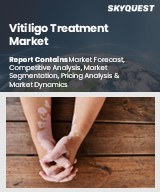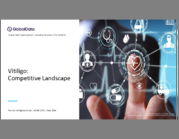
|
시장보고서
상품코드
1806259
백반 치료 시장 : 시장 규모, 점유율, 성장 분석 - 치료 유형별, 약제 클래스별, 유통 채널별, 최종 사용자별, 지역별 산업 예측(2025-2032년)Vitiligo Treatment Market Size, Share, and Growth Analysis, By Treatment Type (Topical Therapy, Phototherapy), By Drug Class (Corticosteroids, Calcineurin Inhibitors), By Distribution Channel, By End-User, By Region - Industry Forecast 2025-2032 |
||||||
세계의 백반 치료 시장 규모는 2023년에 4억 1,000만 달러로 평가되었고, 2024년 4억 2,517만 달러에서 2032년에는 5억 6,858만 달러로 성장할 전망이며, 예측 기간(2025-2032년) CAGR 3.7%로 성장할 전망입니다.
세계의 백반 치료 시장은 질병에 대한 의식이 높아지고, 의료 인프라의 충실, 전문 요법에 대한 액세스 증가 등을 배경으로 크게 성장하고 있습니다. 좁은 밴드 UVB 광선 요법과 국소 야누스 키나아제(JAK) 억제제의 채용은 특히 보험 지원이 충실하고 피부과 의사의 참여가 높아지고 있는 지역에서 지지를 모으고 있습니다. 아시아태평양은 진단률을 높이기 위해 도시 클리닉의 확대 및 공동 교육 노력을 통해 성장을 목표로 하고 있습니다. 게다가 인공지능은 색소 침착의 변화를 정확하게 추적할 수 있게 함으로써 피부과에 혁명을 가져오고, 치료결과 및 환자의 만족도를 높이고 있습니다. 고액의 치료비, 일관성 없는 환불, 문화적 편견 등의 과제에도 불구하고, 원격 피부과와 디지털 헬스 플랫폼은 지방의 의료 격차에 효과적으로 대처하고 있으며, 백반 치료 분야의 장기적 성장을 가속하고 있습니다.
목차
서문
- 조사 목적
- 조사 범위
- 정의
조사 방법
- 정보 조달
- 2차와 1차 데이터의 방법
- 시장 규모 예측
- 시장의 전제조건 및 제한
주요 요약
- 세계 시장 전망
- 공급 및 수요 동향 분석
- 부문별 기회 분석
시장 역학 및 전망
- 시장 개요
- 시장 규모
- 시장 역학
- 성장 촉진요인 및 기회
- 성장 억제요인 및 과제
- Porter's Five Forces 분석
주요 시장 인사이트
- 중요성공요인
- 경쟁도
- 주요 투자 기회
- 시장 생태계
- 시장의 매력 지수(2024년)
- PESTEL 분석
- 거시경제지표
- 밸류체인 분석
- 가격 분석
- 기술 분석
- 사례 연구
- 고객 구매 행동 분석
백반 치료 시장 규모 : 치료 유형별 CAGR(2025-2032년)
- 시장 개요
- 국소 요법
- 광선 요법
- 수술 수술
백반 치료 시장 규모 : 약제 클래스별 CAGR(2025-2032년)
- 시장 개요
- 코르티코 스테로이드
- 칼시뉴린 억제제
- 야누스 키나아제 억제제
백반 치료 시장 규모 : 유통 채널별 CAGR(2025-2032년)
- 시장 개요
- 병원 약국
- 소매 약국
- 온라인 약국
백반 치료 시장 규모 : 최종 사용자별 CAGR(2025-2032년)
- 시장 개요
- 병원
- 피부과 클리닉
- 재택 치료
백반 치료 시장 규모 : 지역별 CAGR(2025-2032년)
- 북미
- 미국
- 캐나다
- 유럽
- 독일
- 스페인
- 프랑스
- 영국
- 이탈리아
- 기타 유럽
- 아시아태평양
- 중국
- 인도
- 일본
- 한국
- 기타 아시아태평양
- 라틴아메리카
- 브라질
- 기타 라틴아메리카
- 중동 및 아프리카
- GCC 국가
- 남아프리카
- 기타 중동 및 아프리카
경쟁 정보
- 상위 5개사 비교
- 주요 기업의 시장 포지셔닝(2024년)
- 주요 시장 기업이 채용한 전략
- 최근 시장 동향
- 기업의 시장 점유율 분석(2024년)
- 주요 기업의 기업 프로파일
- 기업의 상세
- 제품 포트폴리오 분석
- 기업의 부문별 점유율 분석
- 수익의 전년대비 비교(2022-2024년)
주요 기업 프로파일
- Incyte Corporation
- Astellas Pharma Inc.
- Bausch Health Companies Inc.
- Pfizer Inc.
- AbbVie
- Vyne Therapeutics
- Clinuvel Pharmaceuticals
- Accord Biopharma
- Glenmark Pharmaceuticals
- STRATA Skin Sciences
- Aetos Pharma Ltd.
- LEO Laboratories Ltd.
결론 및 권고
AJY 25.09.16Global Vitiligo Treatment Market size was valued at USD 410.0 million in 2023 and is poised to grow from USD 425.17 million in 2024 to USD 568.58 million by 2032, growing at a CAGR of 3.7% during the forecast period (2025-2032).
The global vitiligo treatment market is experiencing significant growth driven by heightened disease awareness, enhanced healthcare infrastructure, and increased access to specialized therapies. The adoption of narrowband UVB phototherapy and topical Janus kinase (JAK) inhibitors is gaining traction, particularly in regions with robust insurance support and heightened dermatologist engagement. The Asia-Pacific region is witnessing growth through expanded urban clinics and collaborative training initiatives to improve diagnosis rates. Additionally, artificial intelligence is revolutionizing dermatology by enabling precise tracking of pigmentation variations, thus enhancing treatment outcomes and patient satisfaction. Despite challenges such as high treatment costs, inconsistent reimbursement, and cultural stigma, teledermatology and digital health platforms are effectively addressing rural healthcare disparities, fostering long-term growth in the vitiligo treatment sector.
Top-down and bottom-up approaches were used to estimate and validate the size of the Global Vitiligo Treatment market and to estimate the size of various other dependent submarkets. The research methodology used to estimate the market size includes the following details: The key players in the market were identified through secondary research, and their market shares in the respective regions were determined through primary and secondary research. This entire procedure includes the study of the annual and financial reports of the top market players and extensive interviews for key insights from industry leaders such as CEOs, VPs, directors, and marketing executives. All percentage shares split, and breakdowns were determined using secondary sources and verified through Primary sources. All possible parameters that affect the markets covered in this research study have been accounted for, viewed in extensive detail, verified through primary research, and analyzed to get the final quantitative and qualitative data.
Global Vitiligo Treatment Market Segments Analysis
Global Vitiligo Treatment Market is segmented by Treatment Type, Drug Class, Distribution Channel, End-User and region. Based on Treatment Type, the market is segmented into Topical Therapy, Phototherapy and Surgical Procedures. Based on Drug Class, the market is segmented into Corticosteroids, Calcineurin Inhibitors and Janus Kinase Inhibitors. Based on Distribution Channel, the market is segmented into Hospital Pharmacies, Retail Pharmacies and Online Pharmacies. Based on End-User, the market is segmented into Hospitals, Dermatology Clinics and Homecare Settings. Based on region, the market is segmented into North America, Europe, Asia Pacific, Latin America and Middle East & Africa.
Driver of the Global Vitiligo Treatment Market
The global vitiligo treatment market is experiencing significant growth driven by widespread initiatives from dermatology societies, social media campaigns, and international health programs that aim to destigmatize the condition and raise awareness about its treatability. This shift in perception encourages individuals to seek early diagnosis and medical advice, predominantly in urban centers. As more patients access treatments such as phototherapy and topical therapies, adoption rates rise substantially. Additionally, the pharmaceutical industry is collaborating with awareness campaigns to improve access to treatments, particularly in developing regions, thus further enhancing the overall growth potential of the global vitiligo treatment market.
Restraints in the Global Vitiligo Treatment Market
Despite significant advancements in treatment options, the high cost of these innovative therapies poses a major challenge to the global vitiligo treatment market. Many patients in emerging markets find advanced topical treatments and biologics prohibitively expensive. In more developed regions, hurdles such as reimbursement complexities and insurance gaps further restrict access to necessary treatments. This situation not only limits the availability of effective therapies for those in need but also hinders the overall expansion of the market. Consequently, affordability remains a critical barrier that impacts the growth and accessibility of vitiligo treatments worldwide.
Market Trends of the Global Vitiligo Treatment Market
The global vitiligo treatment market is witnessing a notable shift towards the adoption of topical JAK inhibitors, which are emerging as a revolutionary therapeutic option. These agents facilitate site-specific repigmentation with enhanced convenience for patients and reduced systemic side effects, thereby improving treatment adherence and outcomes. As clinical performances show promising results and regulatory approvals continue to expand, the demand for these innovative treatments is surging in both developed and emerging markets. This trend signals a significant evolution in autoimmune dermatology, establishing new benchmarks for efficacy and patient safety while driving sustained market growth in the vitiligo treatment landscape.
Table of Contents
Introduction
- Objectives of the Study
- Scope of the Report
- Definitions
Research Methodology
- Information Procurement
- Secondary & Primary Data Methods
- Market Size Estimation
- Market Assumptions & Limitations
Executive Summary
- Global Market Outlook
- Supply & Demand Trend Analysis
- Segmental Opportunity Analysis
Market Dynamics & Outlook
- Market Overview
- Market Size
- Market Dynamics
- Drivers & Opportunities
- Restraints & Challenges
- Porters Analysis
- Competitive rivalry
- Threat of substitute
- Bargaining power of buyers
- Threat of new entrants
- Bargaining power of suppliers
Key Market Insights
- Key Success Factors
- Degree of Competition
- Top Investment Pockets
- Market Ecosystem
- Market Attractiveness Index, 2024
- PESTEL Analysis
- Macro-Economic Indicators
- Value Chain Analysis
- Pricing Analysis
- Technology Analysis
- Case Studies
- Customer Buying Behavior Analysis
Global Vitiligo Treatment Market Size by Treatment Type & CAGR (2025-2032)
- Market Overview
- Topical Therapy
- Phototherapy
- Surgical Procedures
Global Vitiligo Treatment Market Size by Drug Class & CAGR (2025-2032)
- Market Overview
- Corticosteroids
- Calcineurin Inhibitors
- Janus Kinase Inhibitors
Global Vitiligo Treatment Market Size by Distribution Channel & CAGR (2025-2032)
- Market Overview
- Hospital Pharmacies
- Retail Pharmacies
- Online Pharmacies
Global Vitiligo Treatment Market Size by End-User & CAGR (2025-2032)
- Market Overview
- Hospitals
- Dermatology Clinics
- Homecare Settings
Global Vitiligo Treatment Market Size & CAGR (2025-2032)
- North America (Treatment Type, Drug Class, Distribution Channel, End-User)
- US
- Canada
- Europe (Treatment Type, Drug Class, Distribution Channel, End-User)
- Germany
- Spain
- France
- UK
- Italy
- Rest of Europe
- Asia Pacific (Treatment Type, Drug Class, Distribution Channel, End-User)
- China
- India
- Japan
- South Korea
- Rest of Asia-Pacific
- Latin America (Treatment Type, Drug Class, Distribution Channel, End-User)
- Brazil
- Rest of Latin America
- Middle East & Africa (Treatment Type, Drug Class, Distribution Channel, End-User)
- GCC Countries
- South Africa
- Rest of Middle East & Africa
Competitive Intelligence
- Top 5 Player Comparison
- Market Positioning of Key Players, 2024
- Strategies Adopted by Key Market Players
- Recent Developments in the Market
- Company Market Share Analysis, 2024
- Company Profiles of All Key Players
- Company Details
- Product Portfolio Analysis
- Company's Segmental Share Analysis
- Revenue Y-O-Y Comparison (2022-2024)
Key Company Profiles
- Incyte Corporation
- Company Overview
- Business Segment Overview
- Financial Updates
- Key Developments
- Astellas Pharma Inc.
- Company Overview
- Business Segment Overview
- Financial Updates
- Key Developments
- Bausch Health Companies Inc.
- Company Overview
- Business Segment Overview
- Financial Updates
- Key Developments
- Pfizer Inc.
- Company Overview
- Business Segment Overview
- Financial Updates
- Key Developments
- AbbVie
- Company Overview
- Business Segment Overview
- Financial Updates
- Key Developments
- Vyne Therapeutics
- Company Overview
- Business Segment Overview
- Financial Updates
- Key Developments
- Clinuvel Pharmaceuticals
- Company Overview
- Business Segment Overview
- Financial Updates
- Key Developments
- Accord Biopharma
- Company Overview
- Business Segment Overview
- Financial Updates
- Key Developments
- Glenmark Pharmaceuticals
- Company Overview
- Business Segment Overview
- Financial Updates
- Key Developments
- STRATA Skin Sciences
- Company Overview
- Business Segment Overview
- Financial Updates
- Key Developments
- Aetos Pharma Ltd.
- Company Overview
- Business Segment Overview
- Financial Updates
- Key Developments
- LEO Laboratories Ltd.
- Company Overview
- Business Segment Overview
- Financial Updates
- Key Developments



















